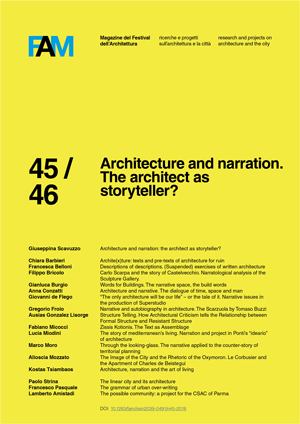Articles
Descriptions of descriptions. (Suspended) exercises of written architecture
Published 2019-01-02
Keywords
- Description,
- Architectural design,
- Architecture,
- Pasolini
How to Cite
Belloni, F. (2019). Descriptions of descriptions. (Suspended) exercises of written architecture. FAMagazine. Research and Projects on Architecture and the City, (45/46), 24–37. https://doi.org/10.12838/fam/issn2039-0491/n45/46-2018/212
Abstract
Since its pre-classical antecedents, the whole history of architectural thought has been characterised by a descriptive literary form. Though not exhaustive in defining the role and cognitive task of the discipline, the description – as an analytical device – is one of the favourite operative tools of architecture and this is true not just nowadays, at the time of storytelling, but has always been so since ancestral times. A long tradition can definitely be traced, whom only recently a name has been given to, perhaps on the wave of that predisposition to self-reflection of architecture on herself, inaugurated with the century of Enlightenment, specified in the Short Twentieth Century and become today way of thinking.References
- BONFANTI E. (1970) – “Elementi e costruzione. Note sull’architettura di Aldo Rossi”. Controspazio, 10 (ottobre).
- BOTTIROLI G. (2002) – “Introduzione a Flaubert”. In: Flaubert G., L’educazione sentimentale, Einaudi, Torino.
- BOULEE E.-L. (1976) – “Architecture, Essay on Art”. In: ROSENAU H., Boullée and Visionary Architecture, Academy Editions, London.
- BRAGHIERI N. (2004) – “Tradurre, Trasmetter, Tradire”. Trans-late (Publikationsreihe des Fachvereins der Studierenden am DArc der ETH-Z), 12, 88-95.
- CANETTI E. (1973) – La provincia dell’uomo, Adelphi, Milano.
- COLAZZO C. (2002) – Musica al cinema: l’opera, Giunta della Provincia Autonoma di Trento, Trento.
- CORBELLINI G. (2016) – Lo spazio dicibile. Architettura e narrativa, letteraventidue, Siracusa.
- ECO U. (2012) – “Il realismo minimo”. La Repubblica, 11 marzo 2012.
- FABBRI P. e MARRONE G. (2001) – Semiotica in nuce. Volume II. Teoria del discorso, Meltemi Editore, Roma.
- GRASSI G., (1967) – La costruzione logica dell’architettura, Marsilio, Padova.
- GRASSI G., (1980) – “Il rapporto analisi-progetto”. In: Grassi G., L’architettura come mestiere e altri scritti, Franco Angeli, Milano.
- JAKOB M. (2005) – Paesaggio e letteratura, Leo S. Olschki Editore, Firenze.
- KRUFT H.-W. (1985) – Geschichte der Architekturtheorie von der Antike bis zur Gegenwart, München.
- LOOS A. (1924) – “Von der Sparsamkeit”. Wohnungskultur, 2-3, 1924.
- PASOLINI P.P. (1979) – Descrizioni di descrizioni, Einuadi, Torino.
- ROSSI A. (1966), Lecture held on 19 April 1966 at the IUAV, course of Teoria della progettazione, a.y. 1965-66, typewritten..
- ROSSI A. (1968) – “Architettura per i musei”. In: Canella G., Coppa M., Gregotti V., Rossi A., Samonà A., Scimemi G., Semerani L. e Tafuri M., Teoria della progettazione architettonica, Dedalo, Bari.
- ROSSI A. (1981) – A Scientific Autobiography, The MIT Press, Cambridge Mass.-London.
- SAVI V. (1976) – L’architettura di Aldo Rossi, Franco Angeli, Milano.
- SOUTO DE MOURA E. (2012) – Souto de Moura. Au Thoronet, le diable m’a dit…, Parenthèses, Marseille.
- (Treccani.it) [online]. Disponibile a: http://www.treccani.it/vocabolario/ecfrasi/ [Ultimo accesso 1 maggio 2018].
- TSCHUMI B. (1996) – Architecture and Disjunction, The MIT Press, Cambridge Mass.-London.
- WITTKOWER R. (1962) – Architectural Principles in the Age of Humanism, Alec Tiranti, London.

